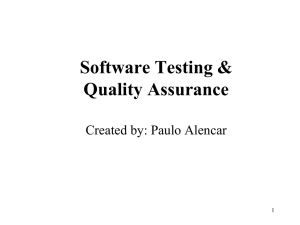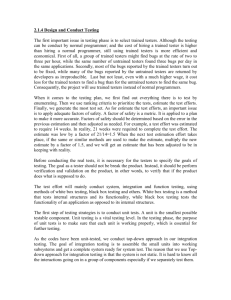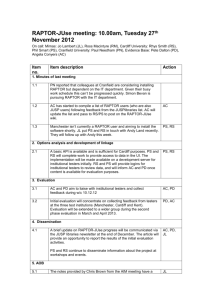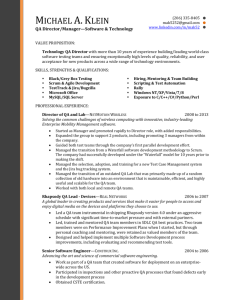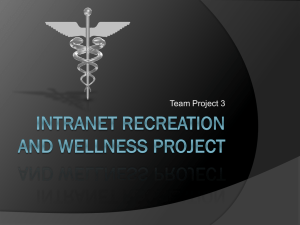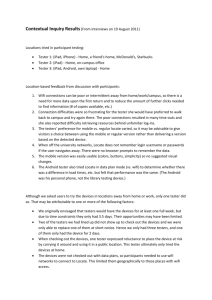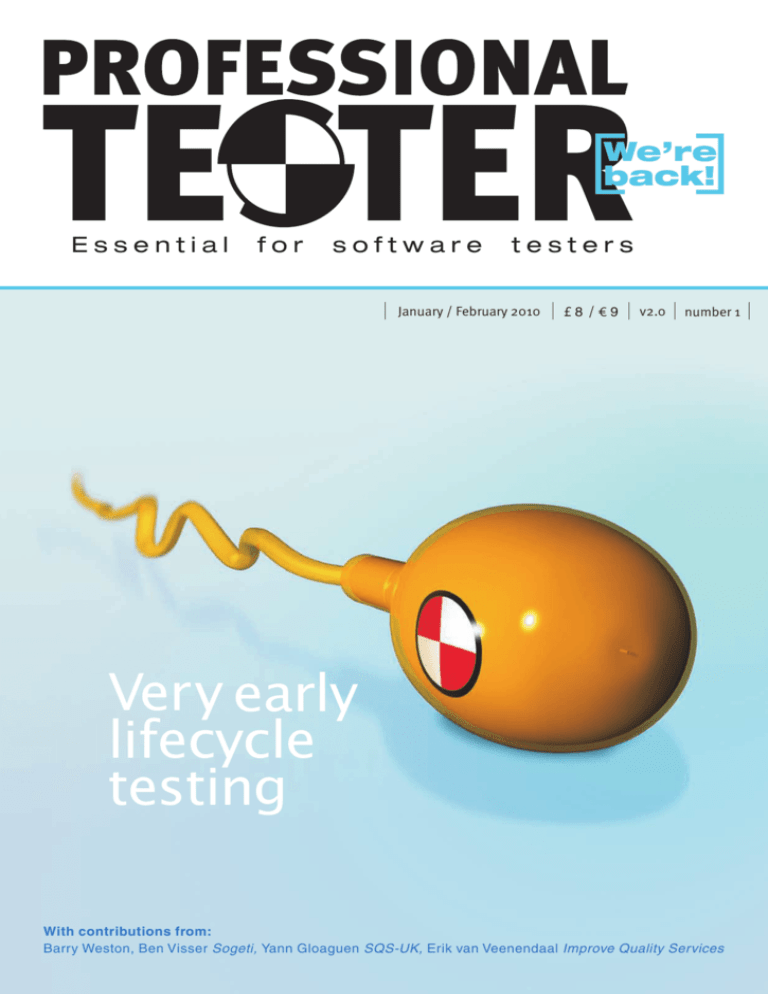
TE TER
We’re
back!
Essential
for
software
testers
January / February 2010
£8 /¤9
v2.0
number 1
Very early
lifecycle
testing
With contributions from:
Barry Weston, Ben Visser Sogeti, Yann Gloaguen SQS-UK, Erik van Veenendaal Improve Quality Services
Introducing TPI NEXT
®
Sogeti’s Business Driven Test Process Improvement
The world’s leading
approach for improving
test processes... has
now been enhanced!
Sogeti’s new book, TPI® NEXT, Business
Driven Test Process Improvement written
by Sogeti test experts and validated
by extensive customer field tests, builds
on the strengths of the successful original
model and provides invaluable insight
and recommendations on the maturity
of an organization’s test processes.
What’s new about TPI® NEXT?
— Key focus on alignment with business
drivers is at the heart of the model
— Reflects Agile and Outsourcing changes
in testing environment
— New ‘Enablers’ to identify the impact on
broader Software Development Lifecycle
How TPI® NEXT can help your test organization
— Develop a clear improvement path to
improve quality, reduce time and save costs
— Ensure processes support the most
important business drivers
— Gain a better understanding of the
correlation between testing and other
software development processes.
Order your copy now!
Available from 17 November 2009 from
specialist publisher UTN at www.utn.nl
or contact Sogeti at tpi@sogeti.nl.
— Clear maturity levels – Controlled,
Efficient and Optimizing
TPI® NEXT an indispensable step-by-step
guide to improving your organization’s
testing processes.
— Easy-to-view representation
for business management.
www.sogeti.com
TE TER
From the editor
Welcome
This is the relaunch issue of
Professional Tester! Welcome to
readers old and new. We aim to
provide practical help and
inspiration to testers everywhere,
and invite you to be involved.
them? Can you test what doesn't yet exist?
In this issue we argue that you can and must if
danger and waste are to be minimized. VELT is
challenging, but is the essence of testing – not just
reacting to the work of others, but leading and
driving quality improvement.
Very Early Lifecycle Testing
In the next issue: testing new technologies
In 2009 a revolution began in business IT. Very
rapid adoption of cloud computing, virtualization,
everything-as-a-service and other newly-enabled
concepts will change the ways testing is done – or
might make large parts of it obsolete. In the past
testers have suffered by failing to keep up with
development trends. That can't be allowed to
happen again: testers must understand the
technologies they will soon be asked to assure.
To produce software, it is nearly always necessary to
define its requirements. This is true regardless of
whether a sequential, iterative, incremental or other
lifecycle model, or no model at all, is used.
Contact
Editor
Edward Bishop
editor@professionaltester.com
Managing Director
Niels Valkering
ops@professionaltester.com
Art Director
Christiaan van Heest
art@professionaltester.com
Sales
Rik van Erp
Hakeem Serbouti
advertise@professionaltester.com
Contributors to this issue:
Barry Weston
Ben Visser
Yann Gloaguen
Erik Van Veenendaal
Publisher
Jerome H. Mol
publisher@professionaltester.com
Subscriptions
subscribe@professionaltester.com
Sequential lifecycle models tend to rely on producing
detailed, rigorous requirements at an early stage as a
basis for subsequent products. There is risk that if
requirements or constraints change, changing those
products will prove very costly.
Other lifecycles – let's use the umbrella term “agile”
for convenience – use less detailed and/or formal
requirements, allowing the developers to take
guesses at what the stakeholders want, and then
make adjustments to the developing software as
necessary if guesses prove wrong. There is risk that
the number and extent of adjustments, and so the
time and effort required to make them, will grow
very large.
The term lifecycle is borrowed from biology, and like
a real lifecycle the software lifecycle begins not with
birth but conception (as in life, the conception is
usually the more enjoyable). Exactly the same
applies to software – but for software, the concept
must be tested. So how can test activities begin
when there is little or no material on which to base
In the next issue of Professional
Tester, we examine the new
challenges and share
experience of both testing
them, and using them to test.
As always, we invite you to
email us your ideas and
opinions in any form. If you
would like to contibute an
article please ask for our
guidelines and let us know what
you have in mind before starting
to write.
Edward Bishop
Editor
In this issue
Very Early Lifecycle Testing
4 VELT in TPI® NEXT
Professional Tester is published bimonthly
by Test Publishing Ltd.
Email: editor@professionaltester.com.
We aim to promote editorial independence
and free debate: views expressed by
contributors are not necessarily those of the
editor nor of the proprietors.
©Test Publishing Ltd 2010.
All rights reserved. No part of this
publication may be reproduced in any form
without prior written permission.
“Professional Tester” is a trademark of Test
Publishing Ltd.
Barry Weston and Ben Visser examine
what TPI® NEXT says about VELT
9 VELT for web
11 Improving process improvement
Erik Van Veenendaal introduces some
less well known approaches to TPI
Features
Edward Bishop on making something
testable from nothing
13 Rude coarse analysis
Articles
10 Incident log
6 Towards quantitative governance
Yann Gloaguen explores meaningful
test success metrics
Tall tale, bad luck or outrage? You decide
A testing view of recent IT news
15 Test library
New books of interest to testers reviewed
PT - Januar y 2010 - professionaltester.com
3
Very Early Lifecycle Testing
Very early lifecycle testing
in TPI® NEXT
Both the original TPI® and the new version
TPI® NEXT identify early testing involvement
as an indicator of good process. They also
promote the practice less directly.
suggestions to promote compliance with
the checkpoints. The lowest level is called
Initial and indicates an immature process
awaiting improvement work. The
improvement suggestions for K02 Degree
of involvement to reach the next level,
Controlled, include:
Contact both line and project management
to emphasize the necessity of (an early)
involvement of testing
Start as early as possible with planning
the test activities, preferably at:
Project initiation, otherwise at:
Start of the test basis, otherwise at:
Completion of the test basis
Barry Weston and
Ben Visser of Sogeti
examine what TPI® NEXT,
the updated version of
Sogeti's Test Process
Improvement methodology
launched in December
2009, has to say about
very early lifecycle testing
and find strong support for
the assertion that it makes
risk reduction more costeffective.
4
PT - Januar y 2010 - professionaltester.com
It's widely accepted that the earlier in the
software development lifecycle testing
begins, the less expensive the
development process becomes.
The V Model as discussed in most training
syllabuses suggests that testing should
begin when the first draft of business
requirements becomes available. But is
this early enough? What should “very
early” mean at project level?
So although it might be possible for a
process to achieve the Controlled level
without VELT, the model indicates that
doing more VELT will make that easier
and more likely.
VELT to inform stakeholders'
risk analysis
Key area K01, Stakeholder commitment
also has bearing on VELT. For a process
to achieve the Controlled level,
Being actively involved before the first
“stakeholders must commit to and support
requirement has been written gives testers the test process by granting and delivering
more influence. The challenge is to make
negotiated resources”. The resources
project and development managers see
required depend upon product and project
that as a good thing.
risk, and VELT can provide often dramatic
assistance here by identifying more risks
Involving testing earlier
earlier on. Informing the stakeholders' risk
In TPI NEXT, the point at which testers
analysis in this way makes the need for
become actively involved is dealt with
resources more apparent and so the
most explicitly in Key Area K02, known as negotiation more meaningful.
Degree of involvement [see panel]. The
model provides checkpoints for every key
In particular, detecting inadequacies in
area that are used to assess which of four whatever requirements information
levels of maturity an organization's test
currently exists and communicating the
process has achieved, and improvement
risks those inadequacies pose often
Looking for a tester?
provides opportunities to influence the
choice of and secure resources for an
effective review process to maximize the
chances of finding weaknesses in designs
based upon the requirements at the
earliest opportunity.
VELT as an integral part of, and to
define, test strategy
Key Area K03 is Test strategy. At the
Controlled level, “prioritization and
distribution of the test effort is based on
the product risks” - that is, the test strategy
is a development from the risk analysis
described in K01 and which, as we have
seen, is greatly enhanced and made more
accurate by VELT.
In describing its significance, the model
states that it “aims at detecting the most
important defects as early and cheaply as
possible”. How to decide what is possible
is not addressed, and of course there are
many defects VELT cannot detect; but the
model defines the “most important” defects
as those with the highest associated
product risks and it is easy to argue, both
from intuition and experience, that
incomplete or ambiguous requirements are
a strong candidate.
The remaining thirteen key areas in TPI
NEXT and the richly detailed checkpoints
and improvement suggestions contained
within them deal with later, more empirical
activities which are the only ways of
detecting defects in the subsequent
development products. But it's clear from
the structure of the model - and, we
suggest, from experience - that success
there is highly dependent on improvement
at K01, K02 and K03. If we accept that and
consider what is said and implied in these
first three key areas, it's hard to avoid the
conclusion that TPI NEXT's authors and
contributors consider that carrying out
more test activities very early is central to
making the entire test process more
mature
K02 Degree of involvement
Significance: Tight involvement of testing in the
project helps to improve the product quality from
the beginning, and helps to keep test activities
off the project's critical path: Timely preparation
and coordination between different tests can be
done and the time that the test project is on the
critical path of the project can be kept as short
as possible. Early involvement of the test team in
the software development lifecycle helps to find
defects as soon and easily as possible and
perhaps even to prevent errors. At an early stage
the test team supports the analysis of project
risks and the review of requirements and
designs.
From TPI® NEXT Business Driven Test Process
Improvement,
© 2009 Sogeti Nederland BV
Barry Weston (barry.weston@sogeti.com) is a senior consultant at Sogeti UK and
Ben Visser (ben.visser@sogeti.nl) at Sogeti Netherlands. Ben is a co-author of the
books “TPI® NEXT Business Driven Test Process Improvement” and “TMap NEXT®
Business Driven Test Management” published by UTN (www.utn.nl). Sogeti Group is
a leading provider of professional technology services in Europe, the US and India.
Place your ad here
www.professionaltester.com/jobs
Mobile Software Testers
Testers needed for Hosted
BlackBerry solutions
www.ColibriMobile.com
Seeking Software Testers
Service management solutions
provider is looking for testing
professionals
www.PROLIN.com
Subscribe now to PT
Magazine!
and receive Europe’s original software
testing magazine every other month
www.professionaltester.com
Want to contribute?
Next PT issue: Testing new
technologies.
www.professionaltester.com
ve
You couldhheare
your ad
Only £125 - €150
per ad per issue
advertise@professionaltester.com
Test management
Towards quantitative governance
Defining the targets that really support
management of a test service
When testing functions are outsourced, the
various partners and stakeholders often
perceive success or otherwise differently.
Typically, the provider believes its
performance is good, testers in the
development organization are ambivalent
and the parent business is unhappy.
Offshoring expert
Yann Gloaguen of
SQS-UK explores
meaningful test success
metrics and how to
measure them
This unevenness is often blamed on
ineffective communication. The business
says that timelines, specifications and
prioritisation have been misunderstood;
the provider says they are in fact
inappropriately defined. Some suggest
addressing this problem by formalizing
communication processes, creating more
and earlier opportunities to notice
discrepancies in understanding. However
this can also have negative impact on
delivery if forced upon organisations for
which it is not a good fit.
Other people believe the main problem is
expectations. Early in the engagement
definition qualitative assumptions tend to
be made, some of which may not be
tested until a time significantly after the
service delivery begins. When they prove
incorrect, surprise followed by
dissatisfaction ensues. An obvious and
typical solution is to specify key
performance indicators and service level
agreements in comprehensive contracts,
reviewed and signed off by sponsors and
lawyers from both sides. However
experience shows the success perception
gap continues to exist despite this work.
The definition of a metric must include
its measurement method
I believe that is because the contracts
often fail to detail the measurements to be
taken for comparison with the defined
targets. “Staff retention”, “capacity buffer”,
6
PT - Januar y 2010 - professionaltester.com
“productivity”, “defect detection”,
“milestones met” and “test coverage” are
metrics commonly found in contracts
and/or used to govern a testing service.
Yet their meaning differs from one
organization to another. The ways they are
measured can look inappropriate to the
unsatisfied; it's easy to get the impression
the measurement has been designed to
ensure the agreed targets are shown to
have been met.
“Staff retention” often contains a
“planned/unplanned staff loss” component
calculated on a “rolling period”. But what is
that? Suppose the target metric is 75%
staff retention and there is a team of 40
testers on the 1st January. To some, that
means simply that the target is achieved if
30 of them are still in the team at the end
of January. But others will adjust for those
testers who it is already known will be
leaving, and count only unplanned loss.
So we need to add a definition of that: for
example, is termination of an individual's
contract planned or unplanned? And what
about project ramp up/ramp down periods,
where the requirements for both size and
skill profile of the team change? How and
when the measurements will be taken and
calculations made needs to be defined
explicitly, based on risk, remembering that
the metric is actually designed to measure
not retention of individual people but of the
knowledge needed to protect business
continuity and efficiency.
Measurement can be intrusive
“Productivity” is one of the most
challenging areas to assess. Some use
“number of tests executed per person per
day”, others “increase in requirements
coverage per effort unit”. The truth is
productivity is a measure of the value
added by individuals over time. Testers
know that their contribution is not in
executing tests but in understanding and
Test management
analyzing change and its impact,
understanding risk, making good choices
of approach, method and technique,
planning and reporting. Business however
tends to associate productivity with the
execution phase of a project and
extrapolate it to other phases, assuming
that if the measurement appears to
increase during the execution it is certain
that we are doing better in planning and
design too. That is not necessarily the
case, because the act of taking
measurements itself impacts individuals
and work processes. Calculating
productivity based on number of test runs
per person per day sometimes causes
testers to create more and ever-smaller
tests! The faster each test can be
executed, the easier it is to achieve the
productivity targets. And that's not the end
of this syndrome: the smaller the tests the
fewer test points in each of them, hence
the more tests required to run for a
release, supporting a business cases for
headcount increase: let's do more, less
efficient, higher-cost testing.
So how can we measure productivity
meaningfully and in a way that tends to
improve rather than worsen actual service
delivery? Here is a proposed method.
Productivity has been defined as “a
measure relating a quantity or quality of
output to the inputs required to produce it”
[2]. This poses two questions: “what does
testing produce?” and “what does testing
require?”.
for governing and giving direction.
It's better to use funding:
number of defects found
during testing
Test progress is not the same as
Productivity =
of testing
total number of defects found quality assurance growth
x money spent on testing
“Test coverage” is another abused metric.
Some calculate test coverage as the
number of tests executed divided by the
number of tests in scope. Others use test
requirements covered divided by total
number of test requirements, or perhaps
number of test requirements covered by
executed tests over the total number of
test requirements. But what about
coverage of the business requirements?
Good testing practice tells us that test
requirements must be derived from
business requirements and that tests must
be derived from test requirements. What
degree of confidence will excellent “test
coverage” give us when achieving poor
“requirements coverage”? When defining
metrics, measurements and targets
business often will overlook this. It is
therefore essential to consult with the QA
organization to agree the precise meaning
of these vital indicators of quality and
progress, and to understand the difference
between them.
If the number of testers is used, what is
being measured is not productivity but
efficiency, the as output per worker per
unit time [4]. To measure the “efficiency
units” spent for a release, we would
average the productivity across features,
applying weights related to test effort per
feature tested:
Where:
E = efficiency units spent
i = represents the feature tested, a
member of the list of n features (eg
functions, business processes etc)
P = productivity as defined above
T = the actual test effort
In contracts, “Capacity Utilisation” often
goes hand in hand with Productivity. This
is most often used for assessing whether
a test team is under-staffed. It should be
used also for understanding how much
effort is spent on different activities.
A “stacked” graph plotting utilization
against time (see figure) is a clear way to
represent capacity utilization.
There is little case for hunting down
numbers or requiring detailed status
reports from the service provider to create
these graphs. The objective is to discover
a trend for forward planning based on how
effort is divided between activities. That
should be used not for audit or control, but
Testing produces quality, by the definition
“the totality of features and characteristics
of a product or service that bears its ability
Capacity utilisation graph
to satisfy stated or implied needs” [3]. For
100
our purposes, this might be measured as
90
the ratio of number of defects found during
80
testing to the total number of defects found.
70
Testing requires testers, but the number of
60
testers is not helpful to measuring
50
productivity because the individuals acting
40
as testers at any given time will be doing
30
different tasks with varying effectiveness.
From the business perspective,
“percentage of milestones met” is a metric
of paramount importance. This should be
a true indicator of expected time to market
and reflection of responsiveness to
business demand. Discussion of it is often
stormy for several reasons: first, the
definition of a milestone. At SQS we have
seen milestones mistaken for tasks and
vice versa many times. Milestones do not
have duration; they are the product of
multiple tasks delivering towards one
Capacity
Training
Process Improvement
Knowledge Transfer
Work Requests
Project Work
20
10
0
1
2
3
4
5
6
7
8
9
10
11
12 Week
PT - Januar y 2010 - professionaltester.com
7
Test management
objective. So “test approach analysis” is
not an example of a milestone; “test
approach document signed off” is. When
tasks are called milestones, we not only
weaken and deviate from the plan by
omitting dependencies, but increase the
number of “milestones”, diluting failures.
This brings us to a second consideration.
Which milestones to choose? They should
be hand-picked from project plans,
selecting the ones that if missed will
impact directly on the business. One could
argue they all will. Selecting them all
however will result in diluting the perceived
impact of a missed one which may in fact
be far more significant than many others
combined. Again testers should be asked
to play a key role in the definition of
milestones in contract, not just test,
documentation.
Conclusion
Communication is rarely to blame for
inconsistent perceptions of achievement
amongst parties; what is communicated is.
Service level agreements and key
performance indicators too often focus on
metrics identification and targets
definition, ignoring means of
measurement and so resulting in
inconsistency of expectations between
participants.
measure of performance and the targets
correct ones by which delivery can be
judged fairly. That would be of benefit to
all parties.
This said, metrics do not deliver projects.
They cannot predict or solve the specific
problems that occur on the ground.
Testing - outsourced or not - needs a
Although they are useful in assessing and
standard defining best metrics and
improving processes, they can never be a
measurements. That would empower
substitute for the creative, pragmatic
managers to build better, more flexible and management that comes from experience.
more effective governance models. That
That should be the first consideration in
can happen only if everyone involved can
any testing-as-a-service engagement
agree that the measurements are a true
[1] http://economics.about.com/od/economicsglossary/g/productivity.htm
retrieved 14th December 2009
[2] ISO 8402:1994 Quality management and quality assurance: Vocabulary
[3] http://economics.about.com/library/glossary/bldef-efficiency-units.htm
retrieved 14th December 2009
Yann Gloaguen (yann.gloaguen@sqs-uk.com) is the offshore delivery manager at SQSUK. SQS Group's success in delivering offshore testing has resulted from having highlyqualified personnel both on and offshore, all trained to use SQS' Global Offshore
Delivery Model which provides proven measurements guaranteeing continuous visibility.
Very Early Lifecycle Testing
VELT for Web
[part one of two]
development environments) that's the only
sensible way for designers and developers
to work.
How to detect defects in
non-existent requirements
Trying to guess at designs in advance is
futile and damaging. Mocked-up pictures
of screens can help business and
developers envisage things approximately
but have no value as a basis for early test
design: they don't contain nearly enough
information and are open to multiple
there you can't review it and no tests will be interpretations. Worse, they are invalid; the
real product will begin to deviate from
created relating to it. In a sequential
them the moment actual design work
development lifecycle, it will then also be
begins. Web requirements should be
missing from subsequent work products
written, never pictorial. If a document
based upon the requirements, for example
contains a picture of the product it
designs, which will likely be fatally flawed
describes, it's a design, not requirements,
throughout as a result. Because these
and of no use for VELT. Anyone tasked
contain information more detailed than
with capturing requirements should be
requirements, they are easier to use as a
test basis, but it's now too late; the design is capable of expressing them in writing. If
not, they probably don't really know what
wrong, the tests will be wrong, and the
the requirements are.
delivered software will have defects probably severe - testing cannot detect.
The kind of requirements written by
business analysts are usually closer in
Think back to the last few times you tried
Software testers specialize in finding
to get information or carry out transactions form to what testers need. They should
things that can be improved in products
on commercial websites, if the memory is describe what the application or change
and processes, including their own work.
should enable the different user groups to
not too painful. The majority of users So they tend to have a lot to complain
do, and the business procedures and rules
even proficient IT users - experience
about. And probably the most popular
that enable test analysis to derive
failure constantly. There is no way to
complaint among testers is of inadequate
expected outputs. But they don't address
monitor functional or usability failure in
information on which to base test design
other fundamental properties which are
production, and therefore no way to
very early in the lifecycle.
crucial to the business success of a publicmeasure its cost - but I believe it is
facing website - the characteristics the site
immense. A large proportion of current
So we want better requirements. But what
web applications, even those operated by should and should not possess, especially
does that mean? What would our ideal
(but not only) in its presentational layer
major organizations, are unfit for purpose
requirements document be like? Clarity,
and user interface. That causes
because intended change to them is not
unambiguity and correctness are all
shortcomings, inconsistencies and
properly documented and therefore not
desirable of course, and the entire test
deviations from prevailing standards to be
adequately tested.
process is designed to detect defects in
noticed during or after functional test
these. Something wrong with a document or
execution, leading to uncontrolled,
So, is it realistic to expect complete
other product used as test basis (an “error
untested, very risky change too late in the
requirements? For some software
of commission”) will hopefully be detected
delivery process which is the main cause
products arguably yes. But for web
by verification, most likely during early test
of rotten websites going into production.
applications, unfortunately not. Nobody
design, or at worst by test execution.
can specify a site, or an addition to an
But testing in any form is powerless against existing site, in sufficient detail, in advance So working within these limitations and
being realistic, how can testers get all the
- no person or group is that clever. The
the worst defect a test basis can have:
important aspects of the site on the test
design aspects of the requirements will
incompleteness. As the first product of
path? The answer is to document them
emerge from the development, as
development, requirements can't be
ourselves as part of the test design activity.
understanding of complex functionality,
validated because there's no earlier
Most of the design decisions affecting the
data, and in particular how to make
document against which to validate them.
navigation and data entry intuitive, grows. new functions will already be known to us,
So something missing (an “error of
or easily predictable. When that is not the
For web (and some other modern
omission”) is far harder to detect. If it's not
Testing is powerless against the worst defect
a test basis can have: incompleteness.
PT editor
Edward Bishop on the
key challenge of VELT:
making something
testable from nothing
PT - Januar y 2010 - professionaltester.com
9
Very Early Lifecycle Testing
case, we can write them generically;
specific information can be added when
available and if necessary.
The deliverable from this activity can be
called “test objectives”. They define what
testing will aim to achieve, and can also act
as the “title” of a test script or other testing
activity during test planning, making
traceability and prioritization easier.
More importantly, in the process of creating
the test objectives we review the business
and other requirements that are available,
detecting defects. By considering those
requirements systematically with reference
to the fundamental functions of any publicfacing website, we add related test
objectives which would otherwise be
omitted.
The review component of this activity can
be made more powerful by enforcing a
rule: that test objectives must be
achievable. This means absolute language
such as “to prove”, “always”, “never” etc
cannot be used, because testing cannot
show that something will always, or never,
happen. Taking care with the wording in
this way often reveals ambiguity in the
requirements and raises useful and
important questions needing clarification.
So creating test objectives can detect not
only errors of omission in requirements,
but other potentially severe defects too,
earlier than they can be detected by test
design.
decided during prioritization and later,
estimation) achievable set of test
objectives for the new functionality, we can
use them as a basis for creating and
detailing test cases, which should reveal if
anything important is still missing
The final part of this article presents a
fully worked, practical example of
applying this method to a real business
requirement. It will appear in the March
issue of PT, or is available to read now,
free at professionaltester.com.
Edward Bishop is author of many training
courses on web testing
Once we have our best effort at what we
consider to be a complete and
theoretically (not practically - that will be
Incident Log
End of browser war could mean
hell or heaven for testers
Some time before 17th March 2010,
Microsoft will issue a Windows Update
recommended for all PCs running Windows
XP, Vista and 7 throughout Europe
designed to make it very easy for Internet
Explorer users to turn all IE functionality off
and install an alternative browser. A “ballot
screen” will appear offering twelve brands,
including all the major and some less well
known ones. It's part of Microsoft's
response to antitrust charges issued
against it by EU regulators at the beginning
of 2009. For full details see
http://computerworld.com/s/article/9142416
(retrieved 18th December 2009).
So, you've tested your public-facing web
application in a benchmark environment
and then performed compatibility testing on
the browsers most of your users prefer?
Think again!
This doesn't affect only web testers. The
browser is the enabling client-side
technology for most cloud service models,
now in massive growth and likely to be
10
PT - Januar y 2010 - professionaltester.com
late-lifecycle tail-chasing bug hunting that
anyone can do.
On the brighter side, if more organizations
opt for analytical compatibility testing,
coding standards and the methods and
tools used to enforce them may be
strengthened. In that case, the applications
So, what to do? Until a good proportion of they produce will tend to work best on
standards-compliant browsers, influencing
users have seen the ballot screen, data
from HTTP logs is useless. Even after that more users to choose them, which in turn
will require more applications to become
things may not settle down: popularity of
browsers is likely to ebb and flow, driven by more compliant... this won't get rid of
abominations such as IE6 overnight but it
incremental improvements and word of
would definitely speed the process up.
mouth. Guessing is very dangerous. The
Instances of standards successfully
only near-certain outcome is a more even
improving matters for the IT industry and
and more fluid spread of installed base
the users it serves are rare as hen's teeth.
between more brands. Organizations
Thanks to Brussels, could we be on the
should be looking now for new ways to
verge of a great one at last?
assure functionality on that wider range.
ubiquitous by the end of 2010. Nearly all
software organizations will be heavily
involved in that.
Most testing budgets won't allow thorough
empirical testing on a lot more client
environments. But not doing it is likely to
give rise to failure near or after deployment.
That means more late fixes and therefore
late regression, and that's
a leading cause of testing being degraded
from the well-integrated, highly-skilled,
process-driven discipline it should be to
Instances of
standards
improving
matters are
rare as hen’s
teeth
Test Process Improvement
Improving process
improvement
To many, test process improvement means following one of the two
best known reference models: TMM (relaunched as TMMi in 2005)
and TPI® (relaunched in late 2009 as TPI® NEXT and discussed in
this issue of Professional Tester). But there is more to TPI than
these.
The ISTQB Certified Tester Expert Level
syllabus of which I am an author, due out
in early 2010, is entitled Improving the
Testing Process. That fact reflects the
importance placed on the subject by
testing thought leaders and their
organizations which face ever-increasing
challenges.
Erik van Veenendaal
introduces some of the
many approaches to
test process
improvement.
There are various angles from which to
work and process-orientated seems to get
the most attention. Others such as peopleoriented (make sure your testers are top of
the class and they will do a better job) or
automation-oriented (use a unit-test
framework and/or automate regression
tests) are also proven ways to improve
testing. Don't focus only on process:
balance your improvement efforts!
The syllabus covers TMMi and TPI® in
detail, but also other process-based
approaches. Here is a selection with
references and brief explanations.
IDEAL [1]
An organizational improvement model that
serves as a roadmap for initiating,
planning, and implementing improvement
actions. The IDEAL model is named for
the five phases it describes: initiating,
diagnosing, establishing, acting and
learning.
Fundamental Concepts of
Excellence [2]
Nine criteria: results orientation, customer
focus, leadership and constancy of
purpose, management by processes and
facts, people development and
involvement, continuous learning,
innovation and improvement, partnership
development and corporate social
responsibility.
Critical Testing Process [3]
A content-based model for test process
improvement built around twelve critical
processes. These are highly visible: peers
and management judge competence and
mission-critical operations where
performance affects profit and reputation.
The model is context sensitive and allows
itself to be adapted, including in
identification of specific challenges,
recognition of attributes of good processes
and selection of the order and importance
of implementation of process
improvements.
STEP (Systematic Test and Evaluation
Process) [4]
A structured testing methodology, also
used as a content-based reference model
for improving the testing process. Does not
require that improvements occur in a
specific order. Seven basic premises:
requirements-based testing strategy,
testing starts at the beginning of the
lifecycle, tests are used as requirements
and usage models, testware design leads
software design, defects are detected
earlier or prevented altogether, defects are
systematically analyzed, testers and
developers work together.
Cause-Effect diagrams (also called
Ishikawa fishbone diagrams) [5]
A brainstorming technique to identify
clusters of causes and symptoms whose
solution will provide the most benefit. It
uses graphical representation to organize
and display the interrelationships of
various possible root causes of a problem.
Possible causes of a real or potential
defect or failure are organized in
categories and subcategories in a
PT - Januar y 2010 - professionaltester.com
11
Test Process Improvement
horizontal tree structure, with the
(potential) defect or failure as the root
node.
Causal analysis during inspection
process [6]
A review technique to facilitate analysis of
the causes of detected defects and
identification of actions to eliminate them.
Goal-Question-Metric (GQM) [7]
An approach to software measurement
using three levels: conceptual level (goal),
operational level (question) and
quantitative level (metric).
Fundamental change management
process [8]
A structured approach to transitioning
individuals, teams, and organizations from
a current state to a desired future state in
eight steps: create a sense of urgency, pull
together the guiding team, develop the
change vision and strategy, communicate
for understanding and buy-in, empower
others to act, produce short-term wins,
don't let up, create a new culture
[1] IDEAL: A User’s Guide for Software Process Improvement, McFeeley. SEI 1996,
CMU/SEI-96-HB-001
[2] efqm.org
[3] Critical Testing Processes, Black. Addison Wesley 2003, ISBN 0-201-74868-1
[4] Systematic Software Testing, Craig and Jaskiel.
Artech House 2002, ISBN 1-580-53508-9
[5] Problem Solving in Groups, Robson. Gower, ISBN 0-566-07415-x
[6] Software Inspection, Gilb and Graham. Addison Wesley 1993,
ISBN 0-201-63181-4
[7] Software Modeling and Measurement: The Goal Question Metric Paradigm, Basili.
University of Maryland 1992, CS-TR-2956 (UMIACS-TR-92-96)
[8] Our Iceberg is Melting, Kotter and Rathgeber. Pan Macmillan 2005,
ISBN 978-0-230-01420-6
Erik van Veenendaal (eve@improveqs.nl) is founder and director of testing consultancy
and training provider Improve Quality Services Ltd, former vice-president of ISTQB,
vice-chair of the TMMi Foundation and author of many books on testing. The beta
version of the ISTQB Certified Tester Expert Level syllabus is available at istqb.org.
DUTCH TESTING CONFERENCE
www.DutchTestingConference.nl
Dutch Testing Conference
21 April 2010 - Spant!, Bussum
Details available on the website www.DutchTestingConference.nl
Platinum Part ners :
Check Gold Part ners online!
Rude Coarse Analysis
Seeking the truth behind
legendary failures
Everyone in testing has heard, and many
have retold, stories of software product
and/or project disasters. They are bandied
about particularly often in training situations,
when course presenters use them to
explain their points, or sometimes just to
reinforce the importance of being aware of
the risks of unexpected failure.
Some classic cases involving space
vehicles and dangerous medical machinery
have been well documented and analyzed
over decades (but still not well enough to
make it obvious what lessons modern
business software testers should learn from
them). More recent ones are probably partly
and possibly wholly apocryphal.
with cross-selling opportunities.
But there was a compatibility failure. Some
users completed signup with no problems,
but clients running Windows 2000 and
Internet Explorer 6 caused a session to be
created that could not be dropped (details
unknown). The servers ran out of memory,
file handles or some other resource very
quickly and the site became unavailable to
all users.
The users didn't want to miss out on their
free points so a lot of them phoned in (a
number was publicized alongside the URL).
Nectar had to hire half of Mumbai to staff
emergency call centres whose function was
to give away free money at great cost. The
loss of cash must add up to a frightening
figure indeed. The loss of potential
customers, reputation and partner
confidence is worse.
rather the actions most users could not
take, because they didn't have an account
yet - were obvious.
So, the prioritization was wrong. More
resources should have been dedicated to
testing the signup process before and after
the launch, and fewer to other functions,
until a specific proportion of the expected
registrations had been completed. Risks
such as “a particular combination of client
platform and browser causes exponential
growth in server resource consumption”
looked relatively unlikely, but when
considered in terms of the signup functions,
to which high traffic had been driven
deliberately by advertising, it was far more
likely than risks to other functions to which
very few users yet had access.
Nectar's explanation at the time was that it
had been surprised by the traffic levels. This
is spin: dressing up a disaster to look like
popularity, by saying “we are so great we
couldn't cope with demand”. Naturally
Nevertheless, they continue to be retold,
commentary on the event was immediately
apparently as fact, by people with no actual
taken up also by marketers pushing
evidence or first-hand knowledge of what
performance testing tools. If used correctly,
happened. Rude Coarse Analysis is where
ie to simulate multiple client configurations,
you can help Professional Tester put a stop
and with more luck, some of these might
to that and discover the real truth.
Testing had been prioritized by risk. An
have detected the defect (the planned
extensive risk catalogue was created and
performance testing was in fact delivered
To get the ball rolling, here are three old
scored. Risks involving loss of money
successfully using various tools). But really
stories we, and probably many of you, have tended to score highest: eg “a customer is
it should have been detected by functional
heard in the last few years - in many cases, able to register for an offer requiring more
integration or system testing, and would
from people who were (or may have been)
points than that customer has accrued”.
have been if critical tests had been
working close to the actual events.
Others that involved large partner
Professional Tester's purpose in retelling
organizations scored high too, especially on executed on common client environments them is research: they may well be partly likelihood, because the functions concerned but the risk analysis said that wasn't
or wholly untrue. If you know that to be the required complex interfacing to the partners' necessary.
case, help us correct the record. We want to systems: eg “points earned by an EDF
help find out what really happened and
Energy customer when paying an electricity 2. NHS patient records system
what, if anything, testers can learn from it.
bill online are not credited to the customer's mistake
This time the culprit was not risk analysis,
Nectar account”.
but risk identification.
1. Nectar launch fiasco
When Nectar, the retail loyalty points card
But, although these are high-scoring risks,
It's easy to criticize some NHS IT initiatives,
used by customers of BP, Sainsbury's and
they were actually very unlikely to happen
but the need for this product was clear to all.
others, was launched a key message of the early in the life of the site when hardly
A patient's medical records, including
blanket advertising was “sign up online and anyone had yet signed up. This is a
imaging and test results, would be available
get free points”; persuading consumers to
common mistake in risk analysis. We tend
to medical professionals, as appropriate
do this was considered desirable because
to consider the likelihood of a defect being
and authorized, at any NHS site the patient
(i) getting the customer to enter their
present: that's different to the likelihood of
attended. There would be no waiting for
personal data is cheaper than doing it
it causing a failure. That depends on the
information from GP surgeries or other
yourself, and (ii) it created a chance to
actions of users, which are usually
institutions or departments. Efficiency,
generate repeat web visits by cardholders,
unpredictable. But in this case they - or
PT - Januar y 2010 - professionaltester.com
13
Rude Coarse Analysis
quality and timeliness of treatment would all
improve. Lives would be saved.
terminals. The terminals include a scanner
for optical mark recognition which inputs the
chosen numbers from a “playslip”
The success or otherwise of the project was completed by the player. This saves time
important for other reasons too, including to and avoids claims that the operator keyed
the government which had authorized the
wrong numbers: it is the player's
huge investment. So at the appropriate
responsibility to check that the numbers on
point in the project, a risk analysis meeting
the ticket printed by the terminal match
was held at 10 Downing Street with Prime
those marked on the playslip.
Minister Tony Blair participating. The risk
catalogue was considered and scored by
When a ticket is purchased, the chosen
consensus; apparently Blair tended to
numbers are transmitted immediately to a
extreme caution and scored nearly
central database. Among other things, this
everything the maximum 10.
allows accurate estimates of the jackpot to
be made prior to the draw, and the number
Crucially however, one risk which later
and geographical location of big winners
turned into reality was missing from the
soon after. Releasing this exciting
catalogue: “medical professionals who
information is a key part of the marketing
should use the system will not accept it”. To strategy and is also required for compliance
be fair to Blair, there is no implication that
with the terms of the operator's licence
he was made aware of this risk, had any
issued by the government; immediacy and
opportunity to envisage it himself, or could
openness helps to ensure and reassure
reasonably have been expected to do so.
that no cheating etc is possible. The
terminals work well; we know of only one
The system was built and tested and proved serious reported failure and that may have
dependable. It retrieved and displayed
been due to network issues beyond
records effectively. But updating records
Camelot's control.
after seeing a patient was unwieldy,
[http://www.guardian.co.uk/uk/2008/dec/28/l
requiring a lot of navigation to complete all
ottery-camelot, retrieved 16th October
necessary fields. Doctors and nurses found 2009]
this took an average of 7 minutes. The time
allocated to a general practice appointment The website is good too; in design and
was 10 minutes, so this caused intolerable
usability at least it may be one of the UK's
delay. Subsequent patients were seen late
best. Selling lottery tickets online is very
and this got worse as the day went on.
desirable because they, like many gambling
purchases, are time dependent. The
The medical professionals were forced to
customer has a strictly limited time in which
go back to making written notes and
to buy, so offering additional and convenient
instructed their administration staff that
channels is vital. There are obvious risks
these must continue be available at patient
too, including high demand as the end of
appointments. Result: a £1.3bn system into the buying window (before the draw)
which nobody was entering any data.
approaches. Camelot operates in a strictly
Lesson: beta testing is too late to detect
regulated environment so development and
acceptance issues, and acceptance testing testing work was carried out to a high
is too late to detect design defects. Static
standard and a clever design that makes it
testing should have prevented this loss
easy for almost anyone to buy and pay for
approximately one year earlier.
tickets, and reduces peak traffic through
identified bottlenecks such as the merchant3. UK National Lottery whitewash
bank interface used to accept debit card
Before it became possible to buy tickets
payments, was implemented.
from the National Lottery website [nationallottery.co.uk], players bought them from
But one requirement proved unexpectedly
retail outlets, where the operator Camelot
difficult to deliver. The data on numbers
installed around 25,000 specially-designed
chosen by online players could not be
14
PT - Januar y 2010 - professionaltester.com
merged easily with that from terminal
sales. The schema used by the terminals
system was complex and not well
understood except by its producers,
whose work had been signed off months
earlier. DBAs working on the website back
end, a much simpler schema built in a
different DBMS, were intimidated. They
dared not risk any operation which might
cause integrity failure - the slightest
suspicion of that would have forced
canceling the draw among other terrible
consequences. Delaying deployment was
an unattractive option too.
There was only one thing for it: deploy on
schedule then take the tickets purchased
online and enter them into the legacy
system. At first this was done manually,
by reading the numbers for a ticket off
screen, completing a playslip, and
processing it just as a newsagent would.
In time, ways were found to achieve more
automation: a line printer rigged to mark
the playslips, then a laptop hardwired to
the terminal, emulating its scanner.
But all this took time. Tickets were being
sold faster than they could be entered. So
the sales function was taken offline from
10pm until 10am every day to allow the
data entry operators to catch up and
statistics to be produced that were
accurate, at least at 10am. Website
providers often call this a “planned outage”
and try to find ways to exclude it from
service level calculations. Everyone else
calls it availability failure.
During these 12-hour periods of
availability failure an announcement
posted on the website gave the impression
that all was normal. When asked for
details, Camelot spokespeople intimated
that the closure was part of its responsible
gambling policy: apparently more
customers tended to make poorly-judged
spending decisions at night or in the early
morning. However the nightly closure is
now much shorter: tickets can currently be
purchased between 8am and 2am.
Perhaps further research revealed the
public’s “window of irresponsibility” was
shorter than previously thought. Or a later
Rude Coarse Analysis
technical solution simply removed the need
for that justification.
Interfacing old and new systems is often
challenging, but in this case the “legacy”
system was very new itself. It would be
fascinating to know if requirements for that
system addressed the predictable need to
import or preferably export mission-critical
data reliably and safely, how the problem
was discovered, and why both functional
(including analysis of data to check
outcomes following test execution) and
non-functional (scalability, interoperability)
testing failed to do so earlier
Were you there? Do you know what really
happened? Or just have an opinion on the
credibility of these accounts? Send an
email to editor@professionaltester.com.
There's no need to reveal your identity,
and if you do we won't publish it unless
you ask us to.
Test Library
Agile Testing
by Lisa Crispin and Janet Gregory
Addison Wesley, ISBN 978-0-3215-3446-0
This book is very well written. Its friendly
conversational style is highly readable yet dense:
there is new information in nearly every
sentence. The frequent stories of experience are
believable and relevant. Panels and figures are
used liberally and to good effect. Theoretical and
How We Test Software
at Microsoft
by Alan Page et al
Microsoft Press, ISBN 978-0-7356-2425-2
A bold title that might make one think it's a
“shortest books” joke. But no, it's a serious 405pager. In fact the title is misleading; the content
is more about software testing in general than
insight into how Microsoft works. It starts from
the basics and introduces all the usual methods
and techniques. Much of this has been done
better in other books, but it's always good to
have another explanation, and the examples
using actual Microsoft products, although
simple, are useful.
However testers looking for new ideas on
TPI® NEXT
by Alexander van Ewijk et al
Sogeti/UTN, ISBN 978-9-0721-9497-8
This review is of the book, not the model itself.
That can be evaluated adequately only in practice
and over years, as has the original TPI®
published in 1998. The experiences and opinions
of the many organizations which used it have
influenced the new version. So even if you have
considered TPI® before, now is the time to look
at it and perhaps try it again.
The advice given in the original model
people-management aspects are covered but the
bulk of the text is practical advice and examples,
including explanations of a range of tools which
more technical testers will find very interesting.
Its best attribute however is the infectious
enthusiasm of the authors: they clearly love their
work and want to share that enjoyment with the
reader. Little wonder, because they appear to
have complete freedom to experiment with
innovative solutions to ever-changing challenges.
Deadlines, budgets and governance simply don't
come into it, and “risk analysis” means vague
guessing of a few things that might go wrong.
So if you are using or attracted to agile
development and finding corresponding test
approaches, and want an evangelical book with
real substance, this is it. If you are more
sceptical, like me, it won't change your mind but
its persuasiveness may disturb you. I found
myself worrying about who pays for all this fun.
process will be disappointed. This is very much
US-style context-driven late-lifecycle testing.
Everything, even application of functional test
techniques, starts from the assumption that the
test item has already been coded. The word
“requirements” is not in the index: I found it only
once, in a diagram used only to dismiss the
waterfall model and in which “maintenance” is
misspelled. The V model is not mentioned;
spiral/agile is the only development lifecycle
given even a cursory explanation.
The authors aim for a very accessible style but
succeed less well than Crispin and Gregory. They
use too many irrelevant analogies and insights
into their personal lives which are boring (the
insights, not their lives). The stories of events
within Microsoft do interest, but the picture they
paint is one of chaos. The developers are firmly
in the driving seat and the testers are really
developers. Example test cases are unrepeatable,
incident reports are laughably informal, and
dubious metrics are of bug creation and
resolution, not detection. Surprisingly, issues are
assigned to individual developers by the tester
raising them: at one point it's suggested that
perhaps it would be a good idea if each
developer with ten or more bugs against his or
her name was asked to fix them all before
continuing work on new features. Er, yes!
Perhaps Microsoft should scale that principle
organizationally, and fix ten faulty products
already sold before launching each new one.
appealed to testers but was hard to justify to
business. The new one addresses that by relating
improvements to testing directly to high-level
“business drivers” such as time to market, cost
reduction, transparency and so on. Other new
sections attempt to make the model more
applicable, showing how it can be used with
more general quality and process improvement
models such as CMMI, in service-based testing
situations, and (less convincingly) with
iterative/agile development lifecycles.
This book, the definitive reference to the
model, is admirably clear and explicit. None of
the seven authors has English as their first
language and that may have been a good thing;
the end product of the translation and editing
process is short sentences that get directly to the
point with few words wasted and nothing hidden
in ambiguity. Typographical and punctuation
defects remain and should be fixed, but I found
none that affect the sense. Criticisms of the
model, including that it is insufficiently rigorous
and too open to varied interpretation, may still be
valid, but the book is hard to fault.
PT - Januar y 2010 - professionaltester.com
15
SWISS TESTING DAY
www.SwissTestingDay.ch
17 March 2010 - Kongresshaus, Zurich
Details available on the website www.SwissTestingDay.ch
Platinum Part ners :
Check Gold Part ners online!

